- Home
- Giles Foden
Turbulence Page 2
Turbulence Read online
Page 2
The Ryman number, by contrast, is a criterion by which the turbulence of weather systems and other flows can be measured. It is dimensionless, which means it can be applied anywhere as a co-ordinate of comparison across space and time. A low Ryman number (less than one) indicates significant turbulence; a higher score (above one) indicates a more typical, ‘stable’ state.
These dimensionless numbers are all about information. They are used as a way of gauging information received. There has been an occasion in my life when (to cut a long and complicated story short) I think I may have had some significant historical influence in employing the Ryman number in this way. The context of this was the meteorological preparations for Operation Neptune in 1944, the first phase of Overlord – or, more popularly, D-Day.
In winter that year I was sent on a special task by Sir Peter Vaward, director of the Meteorological Office. From its reluctant originator I was to discover how to apply a range of values of the Ryman number to a fifty-mile-long invasion site on the coast of France or Belgium. The Ryman number has a direct effect on weather forecasts, because turbulence is associated with patterns of expectation and uncertainty.
Ryman lived in Scotland. Sir Peter had organised a place for me on a meteorological reconnaissance plane on its way from London to Prestwick, which then served the city of Glasgow and the large volume of air traffic arriving from America. It was late January when I set off, and snow was blowing across the airfield as I made my way to the plane (a Halifax), whose propellors were already turning.
In the absence of meteorological information in areas where the enemy operated, a large number of these reconnaissance flights flew daily on sorties all round the British Isles. The plane I was flying in was due to continue from Prestwick to Stornoway on the Isle of Lewis, from where it would fly on the BISMUTH sortie towards Iceland. The aircraft was part of Met 518 Squadron and carried their famous badge painted on its nose – a fist grasping a key with Thaan iuchair againn-ne written underneath, which is Gaelic for ‘We hold the key’.
What did I think was going to happen, as I climbed up into the cabin with my suitcase? Did I have a sense of knowledge about to dawn? What did I feel? It’s very hard to get back to all that. It doesn’t just come gushing out. I often didn’t know what I felt at the time; I often don’t know what I think now. So many of our deepest feelings, in any case, come to us as doubtful, tangled, compound experiences. Events themselves as they happen condition the way we see previous events, making us recalibrate the chain of causation even as we teeter along it, casting all the while a speculative eye at a web of possible futures … This is what living – conscious living – is.
As we took off at around ten I could still taste the baked beans I’d had for breakfast. No doubt about that, even after so many years. I remember the old advertisements, too, with their ‘Always ready to serve’ slogan (more patriotic in those troubled times than ‘57 varieties’, I suppose) and picture of a soldier eating. And then: Don’t think Heinz are making less. We are making more! Fighting men must be fed first; so civilian supplies are limited. But those with a quick eye for the famous name …
Something like that.
I sat up front. The cockpit was cold and draughty. Like the pilot, I had a throat mike and a flying helmet with earphones and goggles – through which, once we were underway, I watched the blizzard increase. The snow hit the glass in loosely defined units, then moved across it fast in a joining mass before being whipped off to the wingtips, where it whirled round like a thick vapour and was flung into our trail. It was in my nature to plot the journey of each snowflake in my head: p = the pressure, h = the height, x = the mass of water per unit mass, v = the velocity per unit mass, y = the entropy …
‘You want to avoid cumulonimbus,’ I said to the pilot, after a while watching the snow clouds. ‘Very bad for turbulence.’
‘To the deuce with that,’ he said, pushing the joystick. We went into a sharp dive. The plane began to spin, a phenomenon at first oddly lacking in turbulence, since it was controlled. Nonetheless, it was terrifying.
I knew that if there was a ‘wobble’ severe turbulence would soon occur and we could lose control of the plane. I had done experiments on this sort of thing while at Cambridge – throwing boomerangs on the Backs and seeing when they would lose aerodynamism, or spinning beach pebbles on wooden surfaces and judging when they would fall.
We continued to drop. A penetrating noise sounded through the riveted aluminium of the cabin. ‘What the hell are you doing?’ I shouted.
We were still heading down, diving through one cloud layer after another, the engine roaring – 6,000 feet, 5,000, 4,000 …
‘Are you telling me how to fly?’ came the reply through the headphones. ‘I’ve been flying cunims since you were in short trousers. This is nothing! I’ve flown in weather in which even the birds were walking.’
I clutched my seat, feeling the beans and bacon rise in my stomach. ‘That may be so,’ I said, ‘but …’ My voice dried up as wordless terror filled my bones.
He stamped on the pedals and pulled out the throttle to full. The nose was still pointing down. I looked at the altimeter in horror. The engine screamed as aero-fuel shot into it – and then in another swift movement he centralised the joystick.
Suddenly we were upright and calm. The needle began to creep round the dial – 2,000 … 3,000 … 4,000 … then he flattened out, allowing the instruments to acquire level values for a minute or two, before starting to climb again steadily.
‘What did you do that for?’ I said angrily as we regained height. ‘Is that your idea of a joke?’ With the increase in height came a faint feeling of my intestines being squeezed.
The pilot laughed. ‘Simmer down, old chap. I was doing a thumb.’
‘A thumb?’ I asked, my heart still racing. Something familiar rubbed at the back of my mind. Not ‘thumb’ – THUM: Temperature and Humidity. The manoeuvre was a legitimate one to record those values at successive heights. But there was no need to do THUMs over the English Midlands.
I spent most of the rest of the journey in sullen silence, staring into the oncoming snow. There was not much I could do. The joker was a Lieutenant Geoffrey Reynolds, who proceeded to tell me about a noteworthy engagement in which he had become involved. Flying back from his sortie he had spotted a U-boat on the surface. The U-boat crash-dived on seeing him but Reynolds attacked with two anti-submarine bombs that exploded just ahead of the wake …
‘The U-boat was virtually blown out of the water, rearing up stern first before sinking. I was bloody chuffed with myself, I can tell you, and headquarters were pretty pleased, too.’
I imagined the U-boat sinking in a widening slick of bubbles and oil and flotsam. ‘They wouldn’t have been quite so happy if the U-boat had had time to call in air support,’ continued Reynolds. ‘Mind you, nothing’s so hairy as picking up damaged instruments from weather ships. The crews sling them out in a waterproof bag on a line attached to a buoy, and we have to fly down and pick up the line with a hook lowered from the undercarriage. Then come round again and throw the new gauges down to the crew. You don’t want Jerry creeping up on you in the midst of that malarkey. It seems a lot of trouble to go to for a broken barometer. I don’t really understand why they don’t just throw the bust ones over the side rather than have us haul them back to be repaired.’
The reason was that these instruments were very expensive and hard to make, but one couldn’t expect an airman to appreciate that. There was often a bit of friction between these pilots and us forecasters, especially on the more remote bases. The pilots depended on us for good information, and they could often be very rude when they didn’t get it, or a forecast went wrong. The issue of authority was complicated by the fact that some forecasters wore RAF uniform and some didn’t, depending on the type of operation in which they were involved.
I had just been promoted to technical officer, but that was a Met rank, not an RAF one. Just the previous week, prior to
Sir Peter’s intervention in my life, I had been a lowly meteorological assistant, a plotter of synoptic charts, a sender up of balloons on £110 a year (£6 income tax).
Mine was an odd way into meteorology, as few practical meteorologists have also been academics. I had been in the Cavendish Laboratory at Cambridge, and I got there at an early age. I was awarded my PhD in 1938, at which time I was twenty-two years old. My thesis was in fluid dynamics, focusing on turbulence and other complexities of flows or ‘dynamical systems’. One encounters a lot of these in continuum physics – it’s all the stuff that’s shifting around, the material that’s hard to quantify because it’s always moving.
In the absence of any particular girlfriend, I’d fallen in love with turbulence while an undergraduate. It is really just the study of whirls and eddies, in particular those that make up, on different scales, the atmosphere in which we all live. Fluid dynamics is also keyholder of our lives in a more intimate way, in that it governs the flow of blood and chemicals through the locks and weirs of body and brain.
I listened to the hum of air passing softly over the machine, blowing past the wings in a whine that was clearly audible despite the whoof-whoof-whoof of the engines. Out of an intense, blue-gleaming whiteness, snowflakes whirled up from the nose. Now and then through the endlessly changing air we fell into patches of larger alteration. Troughs of turbulence, like potholes in a street in an African town – such as where, from under the dirt-stiffened pleat of his shirt, a beggar might reach out a hand for coins.
Those are all the people I have time for now, since G— is gone, those millions of Africa for whom Overlord meant nothing, to whom the generals then and nearly every politician since cast hardly a glance.
G—. I cannot even write the name. Even thinking it causes a sharp, tender shock to spike into my heart.
Flying north, I watched the white flakes spattering the screen. Their shapes, distinct only for a moment, commingled with the thread-like wisps of my thoughts as they came and went. It was as if both were being blown by a wind that would permit no stillness. Everything was swelling, dispersing, happening again and yet not again – for while each thought and each snowflake was different and had its own identity, each was being carried along in the same medium of incalculable change.
War – that altered everything too. The cosy Cambridge world of teacakes and sporting the oak began to disintegrate, chipped away in fragments. One could not just stay at one’s bench in the lab. I saw an advertisement for a training post at the Meteorological Office and, wanting to serve my country in the best way I could, I applied for the job.
On being accepted I was sent to the Central Forecasting Unit at Dunstable. There I studied under Charles Douglas, the senior forecaster. He was an eccentric man but a kind one, and a brilliant meteorologist. He had a phenomenal memory – and some kind of nervous affliction. Something terrible had happened to him during the first war: he was a meteorological observer with the Royal Flying Corps and had been shot down in a dogfight. I once saw him get up in the middle of a meeting and run three times round the table.
But Douglas gave me the best on-the-job training anyone could have got. By 1943 I was research assistant to the superintendent of Kew Observatory, James Stagg, and owner of a small flat in Richmond, having scraped together enough to buy it from savings and the little money that came to me from my parents. Stagg and I worked together on various issues relating to the reflectivity of clouds. Like me, he would be plucked out of his post when the planning for D-Day began.
As we came into Prestwick, I saw that the braziers were out, lines of petrol burners on either side of the runway to aid visibility. And I must say that Reynolds, despite his chirpy offensiveness, made a good job of landing in such difficult conditions.
More snow arrived as we taxied over to the hangar – a blinding wall of wind-driven particles rising like smoke from the ground. As the wind blew, it took the loose new stuff with it, making it slide across the hard, crusted snow that had been compacted by vehicles on the surface of the airfield.
I said thank you and goodbye to Reynolds before disembarking and he grinned at me as he undid his helmet strap, so I suppose we parted on good terms in the end.
I climbed down the ladder, grateful for my Crombie and leather gloves, but very much feeling the lack of a hat as the snowflakes settled on my hair. Still, it might have been cold but I was at the start of my adventure; and besides, for me, unlike most travellers, the snow was a source of great delight. Tumbling softly or flying past fast in a jet, it made the wind visible in all its varieties – for these streams of snow passing over the trodden surface were not regular in scale: some were broad, some narrow; some ran straight, some crooked. Some stopped and flew up into the air, as if in a column. Others were clamped down, as if struck with a hammer. Sometimes these streams, which were often no more than two yards broad, acted as a kind of fence, disclosing the variable action of two other drifts of snow on either side.
Most marvellous of all were those moments when two of these corridors of snow, blown by wind coming from different directions – north and west, say – met and passed through each other, like ghosts at a crossroads.
Now I remember this image I’m struck by its significance; for it was exactly this idea of corridors and barriers, of differential borders marking out the richness and variety of weather, that I would learn from Ryman. My master, so fine and subtle, who knew things perfectly at which I could only grope, reaching for years in Cambridge the skinny hand of thought into the darkness.
Despite the dampening effect of the snow, the braziers made quite a noise, roaring yellow-blue plumes of flame into the frozen air. I noticed an American military plane on the white-shrouded tarmac, and it was an American I first spoke to on entering the airport complex. He was dressed in a USAAF leather flying jacket and cut quite a figure, being rather tall, with a scrap of thick black hair falling over his forehead.
‘This will all be gone by morning,’ said the man, looking out at the gale. ‘It’ll be like it never happened.’ As I was to discover, such optimism of prediction was entirely typical of him. Personally, I don’t think he was the self-serving scoundrel some European observers have made him out to be. He just wanted the best for the world he was part of.
‘I think you’ll find any forecast over three days hence is purely random,’ I said. ‘Beyond two it’s little better than gambling.’
‘Oh yeah?’ he said, pushing back the shock of hair. ‘And who are you to say so?’
‘Henry Meadows,’ I said, trying not to assume an air of superiority. ‘I work for the Met Office, actually.’
He laughed. ‘Holy Moly, what a coincidence.’ He held out his hand. ‘Irv Krick. US Air Force weather service. I’m here on a familiarisation tour. What’s your business?’
I gave him the alibi with which Sir Peter had supplied me. ‘I’m on my way to set up a weather station in the west of Scotland.’
I’d vaguely heard of Krick – he used to work at Caltech, which in those days led the way in American meteorology – and we talked a little about developments in the field. He was on his way home to the United States, but his plane had been grounded. He went to consult his colleagues about the chances of leaving the following day and I turned to watch the storm through the plate-glass window. How was I going to get to Kilmun in this weather? I was supposed to be taking a steamer out to the west coast in a few hours, but that would be impossible now.
I heard Krick’s voice behind me. ‘Me and my buddies are going to hole up in a hotel in Glasgow tonight. If you play poker, we’ll give you a game.’
I considered my limited options. At the very least I needed lunch, so I joined Krick and his assistant Ben Holzman in a military car which took us through the blizzard to a hotel in the centre of the city. The journey was about thirty miles and it snowed the entire length of it.
2
By the time we reached Glasgow it was obvious that there was no chance of travelling any further
that day. We sat down to spuds with mince and onions, followed by whisky and a game of poker in front of a coal fire. If I’m not careful, I thought, as the cards slapped onto the table, I could lose the whole afternoon. I resolved not to – but within minutes the whisky and the warmth had drained all the willpower out of me.
It was as if I had been beguiled by some unearthly siren who kept repeating her promise of unelapsed time and unalloyed happiness until I had to succumb. So it was, over the card play, as coals glowed in the hearth and a waitress in an apron and bonnet supplied us with ice for the Scotch, I listened as Krick told me his remarkable life story.
I had taken an unlikely route into meteorology, but his was far stranger. After taking a physics degree at the University of California he worked as a disc jockey, then as a runner for a company of stockbrokers. ‘Chapman de Wolfe and Company,’ he said, pronouncing it ‘Volf ’ in the German way. ‘As you can imagine, my services were dispensed with pretty rapidly after the Crash in ’twenty-nine. Though I missed the worst of it on my own account.’
‘How?’ I asked, leaning forward.
He grinned, slicking his hair back. ‘I devised a system calibrating financial fluctuations against background randomness, according to certain physical principles. Things have changed a bit since then, but I still use the same basic idea.’
Krick’s theory of stock-market cycles had begun as an innocent intellectual recreation, or so he said, but in years to come he successfully played the markets using his system. The Wall Street Crash was no accident, he maintained. It was a necessary piece of information within a larger story. Ryman, who had none of Krick’s hucksterism, would have agreed. There are no accidents. Every so-called ‘accident’, every piece of turbulence, is part of a sequence, bigger or smaller, whose scale you cannot see. At least, you don’t see it until it’s too late, and then you start to panic, because you realise how foolish was your original fantasy of understanding.

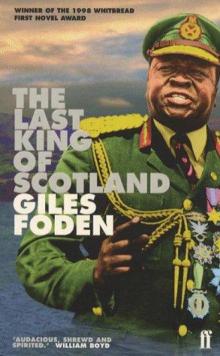 The Last King of Scotland (1998)
The Last King of Scotland (1998) Zanzibar
Zanzibar Turbulence
Turbulence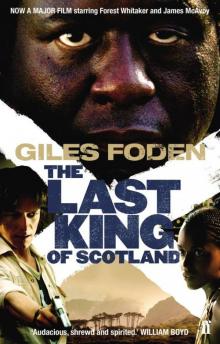 The Last King of Scotland
The Last King of Scotland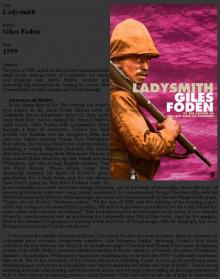 1999 - Ladysmith
1999 - Ladysmith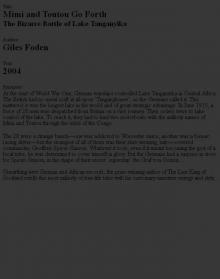 2004 - Mimi and Toutou Go Forth
2004 - Mimi and Toutou Go Forth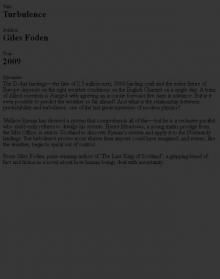 2009 - Turbulence
2009 - Turbulence